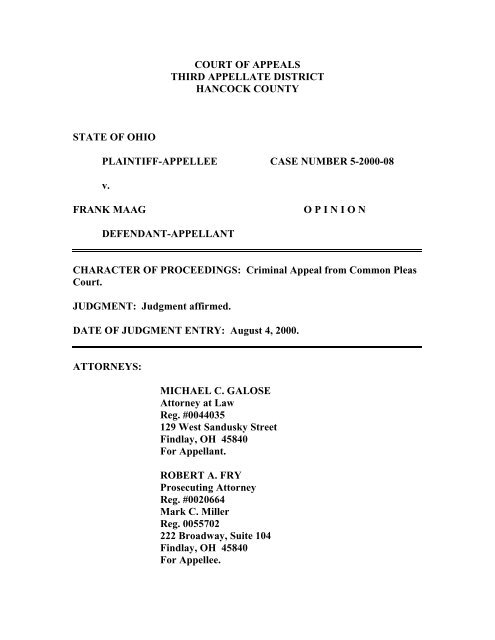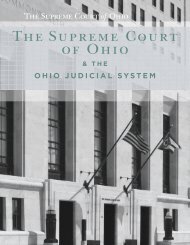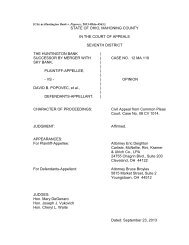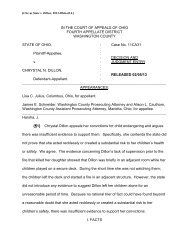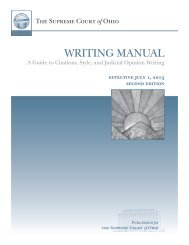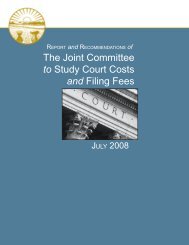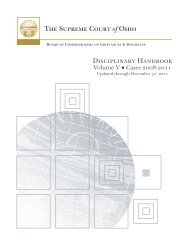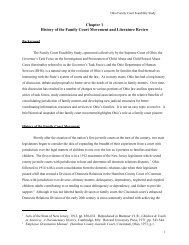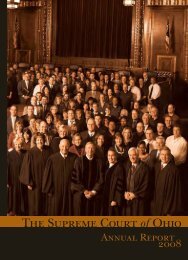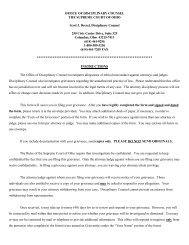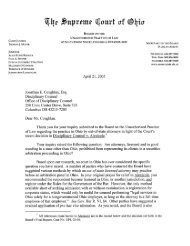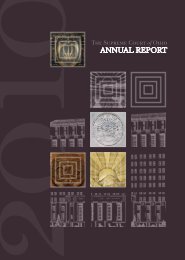State of Ohio v. Frank Maag - Supreme Court - State of Ohio
State of Ohio v. Frank Maag - Supreme Court - State of Ohio
State of Ohio v. Frank Maag - Supreme Court - State of Ohio
You also want an ePaper? Increase the reach of your titles
YUMPU automatically turns print PDFs into web optimized ePapers that Google loves.
STATE OF OHIO<br />
COURT OF APPEALS<br />
THIRD APPELLATE DISTRICT<br />
HANCOCK COUNTY<br />
PLAINTIFF-APPELLEE CASE NUMBER 5-2000-08<br />
v.<br />
FRANK MAAG O P I N I O N<br />
DEFENDANT-APPELLANT<br />
CHARACTER OF PROCEEDINGS: Criminal Appeal from Common Pleas<br />
<strong>Court</strong>.<br />
JUDGMENT: Judgment affirmed.<br />
DATE OF JUDGMENT ENTRY: August 4, 2000.<br />
ATTORNEYS:<br />
MICHAEL C. GALOSE<br />
Attorney at Law<br />
Reg. #0044035<br />
129 West Sandusky Street<br />
Findlay, OH 45840<br />
For Appellant.<br />
ROBERT A. FRY<br />
Prosecuting Attorney<br />
Reg. #0020664<br />
Mark C. Miller<br />
Reg. 0055702<br />
222 Broadway, Suite 104<br />
Findlay, OH 45840<br />
For Appellee.
Case No. 5-2000-08<br />
HADLEY, P.J. The defendant-appellant, <strong>Frank</strong> T. <strong>Maag</strong> ("the appellant"),<br />
appeals from the judgment <strong>of</strong> sentence <strong>of</strong> the Hancock County <strong>Court</strong> <strong>of</strong> Common<br />
Pleas. For the following reasons, we affirm the judgment <strong>of</strong> the trial court.<br />
The pertinent facts and procedural history <strong>of</strong> the case are as follows. In<br />
March 1998, <strong>of</strong>ficers from the Findlay Police Department responded to a report <strong>of</strong><br />
an alleged rape. The victim, Kathy Cornwell, twelve years-old at the time,<br />
informed the <strong>of</strong>ficers that the appellant had raped her at the home <strong>of</strong> her girlfriend,<br />
Julie Campbell, also twelve years-old. At the time <strong>of</strong> the alleged incident, the<br />
appellant was the live-in boyfriend <strong>of</strong> Julie's mother.<br />
According to Kathy's statements, shortly after she and Julie went to bed on<br />
a s<strong>of</strong>a-bed located in the living room, the appellant approached her and began to<br />
orally rape her. Kathy informed the police that the appellant had, on two<br />
occasions, attempted to vaginally rape her, but that she was ultimately able to fend<br />
<strong>of</strong>f his sexual advances. Later that morning, Kathy observed Julie and the<br />
appellant engaging in sexual intercourse. 1<br />
In April 1998, the appellant was indicted by the Hancock County Grand<br />
Jury on five counts <strong>of</strong> rape, in violation <strong>of</strong> R.C. 2907.02(A)(1)(b), each a felony <strong>of</strong><br />
the first degree. On September 22, 1999, pursuant to a negotiated plea agreement,<br />
the appellant pleaded guilty to four counts <strong>of</strong> rape. In exchange for the appellant's<br />
2
Case No. 5-2000-08<br />
guilty pleas, the <strong>State</strong> <strong>of</strong> <strong>Ohio</strong> dismissed the remaining charge <strong>of</strong> rape. The trial<br />
court accepted the appellant's guilty pleas and found him guilty <strong>of</strong> four counts <strong>of</strong><br />
rape.<br />
A sentencing hearing was held on February 10, 2000. The appellant was<br />
sentenced to concurrent seven-year terms <strong>of</strong> imprisonment with respect to count<br />
one and count two <strong>of</strong> the indictment. The trial court sentenced the appellant to<br />
consecutive eight-year terms <strong>of</strong> imprisonment with respect to count three and<br />
count four <strong>of</strong> the indictment. The aggregate seven-year term <strong>of</strong> imprisonment<br />
imposed in count one and count two was ordered to run consecutive to the terms<br />
<strong>of</strong> imprisonment imposed in count three and four. Thus, the appellant was<br />
sentenced to a total term <strong>of</strong> imprisonment <strong>of</strong> twenty-three years.<br />
At the conclusion <strong>of</strong> sentencing hearing, the trial court held a sexual<br />
classification hearing to determine whether the appellant was a sexual predator.<br />
At the conclusion <strong>of</strong> the sexual classification hearing, the trial court notified the<br />
respective parties that a decision upon the appellant's status as a sexual predator<br />
would be forthcoming. The results <strong>of</strong> the sentencing hearing were journalized<br />
pursuant to an entry filed on February 10, 2000. 2<br />
1<br />
The record reveals that the appellant and Julie had an on-going sexual relationship.<br />
2<br />
The sexual classification determination was not journalized in the trial court's judgment entry <strong>of</strong><br />
conviction and sentence.<br />
3
Case No. 5-2000-08<br />
It is from this judgment that the appellant now appeals, setting forth the<br />
following sole assignment <strong>of</strong> error.<br />
ASSIGNMENT OF ERROR<br />
The trial court erred when it sentenced the appellant to<br />
consecutive sentences for an aggregate <strong>of</strong> twenty-three years <strong>of</strong><br />
incarceration.<br />
In his sole assignment <strong>of</strong> error, the appellant maintains that the trial court<br />
erred in sentencing him to consecutive sentences. Specifically, the appellant<br />
asserts that the seriousness and recidivism factors <strong>of</strong> R.C. 2929.12 do not support<br />
the imposition <strong>of</strong> consecutive sentences. 3 For the following reasons, we find no<br />
merit to the appellant's assignment <strong>of</strong> error and affirm the judgment <strong>of</strong> the trial<br />
court. 4<br />
Senate Bill 2 requires a court that sentences a felony <strong>of</strong>fender to be guided<br />
by the overriding purposes <strong>of</strong> felony sentencing, which are protecting the public<br />
from future crime and punishing the <strong>of</strong>fender. R.C. 2929.11(A). Additionally, the<br />
court must impose a sentence "commensurate with and not demeaning to the<br />
seriousness <strong>of</strong> the <strong>of</strong>fender's conduct and its impact upon the victim, and<br />
3 Although the appellant has argued that the standard <strong>of</strong> review <strong>of</strong> a trial court's sentence is abuse <strong>of</strong><br />
discretion, we observe that R.C. 2953.08(G)(1) allows a reviewing court to vacate a sentence and remand it<br />
to the trial court for resentencing only if the appellate court finds, by clear and convincing evidence, that<br />
"(a) the record does not support the sentence; * * * [or] (d) [t]hat the sentence is otherwise contrary to law."<br />
4 Although the judgment entry from which the appellant appeals neglects to set forth a final determination<br />
with regard to the appellant's status as a sexual predator, we find that a final appealable order exists as to<br />
the remaining issues set forth in the judgment entry <strong>of</strong> conviction and sentence.<br />
4
Case No. 5-2000-08<br />
consistent with sentences imposed for similar crimes by similar <strong>of</strong>fenders." R.C.<br />
2929.11(B).<br />
Unless a mandatory prison term is required, the court "has discretion to<br />
determine the most effective way to comply with the purposes and principles <strong>of</strong><br />
sentencing set forth in section 2929.11 <strong>of</strong> the Revised Code." R.C. 2929.12(A).<br />
However, in exercising that discretion, the court must consider the factors set forth<br />
in subdivisions (B), (C), (D), and (E) <strong>of</strong> R.C. 2929.12. Id. These factors relate to<br />
the seriousness <strong>of</strong> the conduct <strong>of</strong> the <strong>of</strong>fender and the likelihood that the <strong>of</strong>fender<br />
will commit future crimes. Id. The sentencing court may consider additional<br />
factors that it finds relevant to achieving the R.C. 2929.11 purposes and principles<br />
<strong>of</strong> sentencing. Id. After performing the seriousness and recidivism analysis<br />
required by R.C. 2929.12, the trial court is guided by R.C. 2929.13 in determining<br />
the sanction or combination <strong>of</strong> sanctions to impose upon the felony <strong>of</strong>fender.<br />
Furthermore, under <strong>Ohio</strong> felony sentencing law, a trial court must make<br />
certain findings prior to sentencing a defendant to consecutive sentences. R.C.<br />
2929.14(E) states, in pertinent part, as follows:<br />
(4) If multiple prison terms are imposed on an <strong>of</strong>fender for<br />
convictions <strong>of</strong> multiple <strong>of</strong>fenses, the court may require the<br />
<strong>of</strong>fender to serve the prison terms consecutively if the court finds<br />
that the consecutive service is necessary to protect the public<br />
from future crime or to punish the <strong>of</strong>fender and that consecutive<br />
sentences are not disproportionate to the seriousness <strong>of</strong> the<br />
<strong>of</strong>fender's conduct and to the danger the <strong>of</strong>fender poses to the<br />
public, and if the court also finds any <strong>of</strong> the following:<br />
5
Case No. 5-2000-08<br />
(a) The <strong>of</strong>fender committed the multiple <strong>of</strong>fenses while the<br />
<strong>of</strong>fender was * * * under post-release control for a prior <strong>of</strong>fense.<br />
(b) The harm caused by the multiple <strong>of</strong>fenses was so great or<br />
unusual that no single prison term for any <strong>of</strong> the <strong>of</strong>fenses<br />
committed as part <strong>of</strong> a single course <strong>of</strong> conduct adequately<br />
reflects the seriousness <strong>of</strong> the <strong>of</strong>fender's conduct.<br />
(c) The <strong>of</strong>fender's history <strong>of</strong> criminal conduct demonstrates that<br />
consecutive sentences are necessary to protect the public from<br />
future crime by the <strong>of</strong>fender.<br />
This <strong>Court</strong> has held that when consecutive sentences are imposed under R.C.<br />
2929.14, the trial court must also set forth its reasons for imposing consecutive<br />
sentences pursuant to R.C. 2929.19(B)(2)(c).<br />
In the case before us, the trial judge stated on the record at the sentencing<br />
hearing that the imposition <strong>of</strong> consecutive sentences was necessary to protect the<br />
public from future crime and to punish the <strong>of</strong>fender. The trial judge further found<br />
that the imposition <strong>of</strong> consecutive sentences was not disproportionate to the<br />
seriousness <strong>of</strong> the appellant's conduct and to the danger he posed to the public.<br />
The trial judge also noted that the appellant committed the instant <strong>of</strong>fenses while<br />
under post-release control for a prior <strong>of</strong>fense. Thus, the trial judge complied with<br />
the statutory requirements <strong>of</strong> R.C. 2929.14(E)(4) in sentencing the appellant to<br />
consecutive terms <strong>of</strong> imprisonment. The trial court also considered the<br />
seriousness and recidivism factors <strong>of</strong> R.C. 2929.12 in support <strong>of</strong> its decision to<br />
impose consecutive terms <strong>of</strong> imprisonment.<br />
6
Case No. 5-2000-08<br />
Although the trial court adequately explained why it had elected to impose<br />
consecutive terms <strong>of</strong> imprisonment, the appellant argues that the court's findings<br />
with respect to the seriousness and recidivism factors <strong>of</strong> R.C. 2929.12 are<br />
unsupported by the record. Initially, the appellant argues that, in imposing<br />
consecutive terms <strong>of</strong> imprisonment, the trial court erred in finding that he had<br />
shown no remorse for his conduct, a factor indicating that he is likely to commit<br />
future crimes pursuant to R.C. 2929.12(D)(5). The appellant also contends that<br />
the trial court erred in neglecting to find that he had shown remorse for his<br />
conduct, a factor indicating that he is not likely to commit future crimes pursuant<br />
to R.C. 2929.12 (E)(5).<br />
A review <strong>of</strong> the record in this case reveals that the appellant did state at the<br />
sentencing hearing that he was remorseful for what he had done, that he had acted<br />
wrongly, and that he would be willing to undergo treatment. Nonetheless, the trial<br />
judge stated on the record that the appellant had shown little remorse for his<br />
conduct, and that he had been less then candid regarding the incidents which<br />
ultimately lead to his arrest and conviction.<br />
This <strong>Court</strong> had repeatedly held that a trial court is in the best position to<br />
address the sincerity and genuineness <strong>of</strong> a defendant's statement at the sentencing<br />
hearing. See <strong>State</strong> v. Bennett (June 21, 2000), Hancock App. No. 5-2000-05,<br />
unreported; see, also, <strong>State</strong> v. Sims (Dec. 9, 1998), Summit App. No. 19018,<br />
7
Case No. 5-2000-08<br />
unreported, citing <strong>State</strong> v. Howard (Sept. 11, 1998), Hamilton App. No. C-<br />
971049, unreported. Because the trial court was in a better position to observe the<br />
appellant's demeanor and sincerity in this case, we cannot say that the court erred<br />
in finding that the appellant did not exhibit genuine remorse for his conduct, a<br />
factor indicating that he is likely to commit future crimes, or that the trial court<br />
erred in failing to consider his remorse, a factor indicating that he is not likely to<br />
commit future crimes. See R.C. 2929.12 (D)(5) and (E)(5). For the foregoing<br />
reasons, we find the appellant's arguments not well-taken.<br />
The appellant next argues that the trial court erred in finding that Julie<br />
Campbell had suffered psychological harm, a factor indicating that his conduct<br />
was more serious than conduct normally constituting the <strong>of</strong>fense. See R.C.<br />
2929.12(B)(2). Because both <strong>of</strong> the victims in the present case were twelve years<br />
old at the time <strong>of</strong> the alleged acts <strong>of</strong> rape, we cannot say that the trial court erred in<br />
concluding that Kathy and Julie had suffered psychological harm. Therefore, we<br />
find no merit to the appellant's argument.<br />
The appellant further maintains that the trial court erred in failing to find<br />
that he had a low likelihood <strong>of</strong> recidivism. In support <strong>of</strong> his position, the appellant<br />
relies upon the October 27, 1999, report <strong>of</strong> the <strong>Court</strong> Diagnostic & Treatment<br />
Center <strong>of</strong> Toledo, <strong>Ohio</strong>, which concluded that the appellant could not be<br />
considered likely to commit further sexually oriented <strong>of</strong>fenses. We have reviewed<br />
8
Case No. 5-2000-08<br />
the record in this case and, despite the finding <strong>of</strong> the Diagnostic & Treatment<br />
Center, cannot in good conscience say that the trial court erred in failing to find<br />
that the appellant had a low likelihood <strong>of</strong> recidivism.<br />
In conclusion, we cannot say by clear and convincing evidence the record<br />
does not support the sentence. Accordingly, the appellant's assignment <strong>of</strong> error is<br />
overruled.<br />
Having found no error prejudicial to the appellant herein, in the particulars<br />
assigned and argued, we affirm the judgment <strong>of</strong> the trial court.<br />
WALTERS and SHAW, JJ., concur.<br />
r<br />
9<br />
Judgment affirmed.


